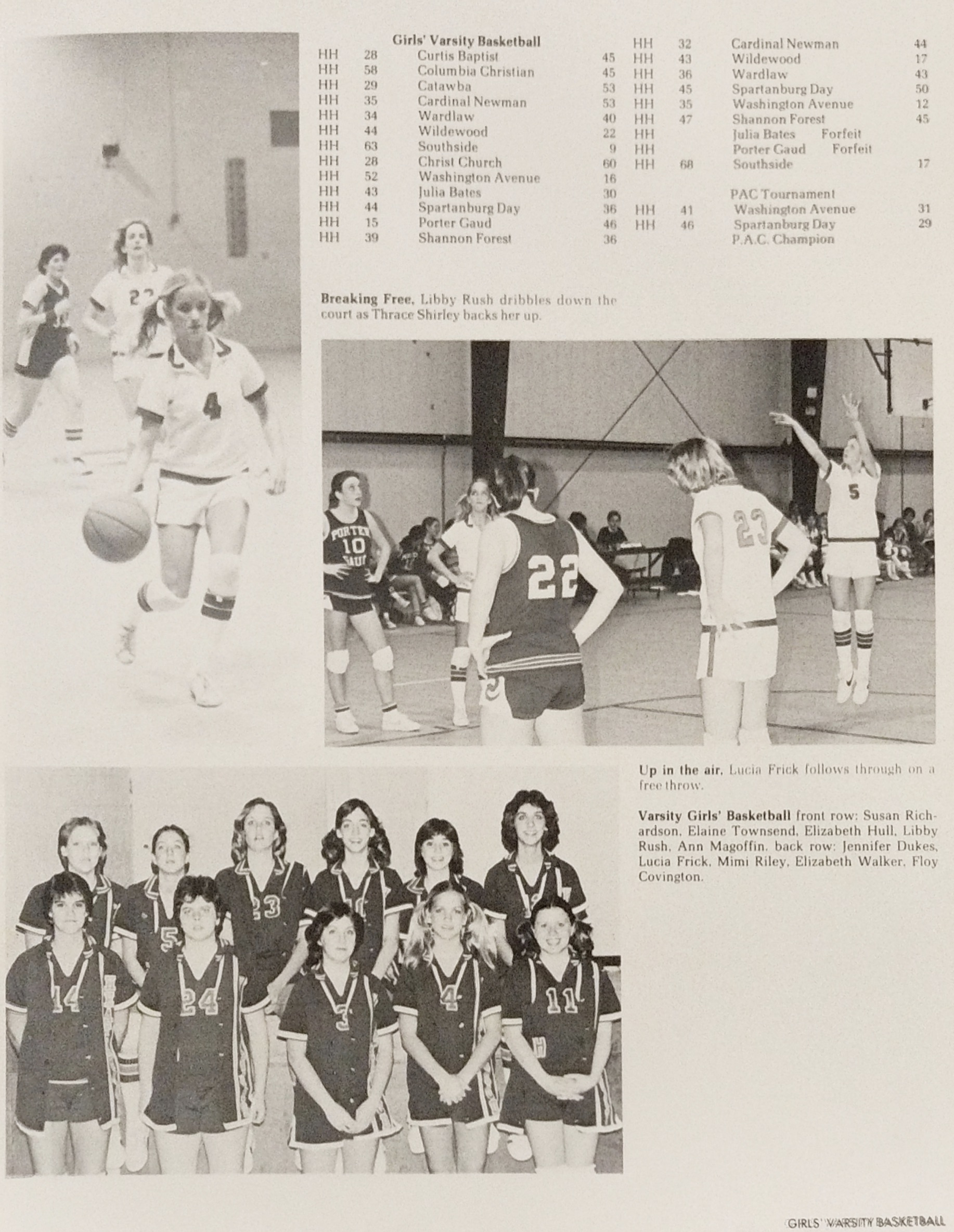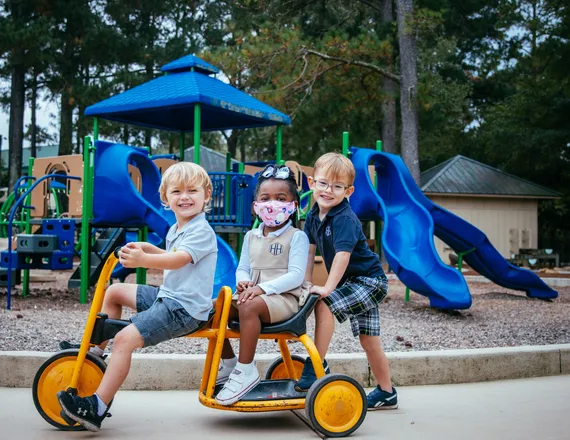School History
Heathwood Through The Decades
In addition to providing an overview of significant events in each decade of the school's history, this page includes links to extensive historical archives, including audio files of interviews of past heads of school, alumni, and many other key members of our community as well as a vast collection of images, yearbooks, and other key documents from the school's founding to the present day. Pictures and video clips are on Google Drive and are downloadable.
- 1950s
-
Pictures from the 1950s on Google Drive

Located in the Heath mansion on Heathwood Circle, Heathwood Hall Episcopal School was started by the Upper Diocese of the Episcopal Church of South Carolina. Using funds from the 1847 trust of Francis Marion Weston, the school purchased the Heath mansion in early 1951. The mansion had been built in 1914 by M.C Heath and sold to the school by his daughters Katharine Manning and Elizabeth Coleman. Another of M.C Heath’s descendants, Burwell Manning, donated the land that would become Heathwood’s current campus.
Led by our first headmistress, Susan Robinson, Heathwood opened its doors on September 10, 1951. Heathwood began with just under 100 students, with classes ranging from Kindergarten to 4th grade. Over our first three years, Heathwood expanded to 6th grade and grew to over 150 students. Classes included music with Ms. Nell Mellichamp and French with Professor Maurice Stephan.
By the end of the decade, Heathwood had over 250 students and expanded its course offerings with multiple religious classes and Latin. Miss Louly Shand’s little red schoolhouse was moved to the school's grounds to accommodate the growing kindergarten classes in 1954. Mary Anderson became Heathwood's second headmistress in the 1956-1957 school year, replacing Susan Robinson upon her retirement.
- 1960s
-
Pictures from the 1960s on Google Drive

The start of the 1960s at Heathwood Hall brought several changes to the school, including a new headmistress. Elsie Lamar became headmistress in the Spring of 1960 and led the school through its second decade. Under her leadership, Heathwood continued to grow to nearly 300 students.
Several new additions to the school also marked the 1960s. The first student council was formed, with Scott Belser serving as student body president. In addition, Columbia Cooks With Fun and Flavor was published in the fall of 1960 and was so successful that it required a second and third printing; it would sell over 6,000 copies.
In 1965 Heathwood enrolled its first African American students. At the same time that many private schools were being founded on segregationist principles, Heathwood was moving in the opposite direction. One of Heathwood's first Black students was Michael Perry, son of civil rights lawyer Matthew J. Perry Jr., who would later become the first African-American from the Deep South to be appointed to the federal bench.
- 1970s
-
Pictures from the 1970s on Google Drive
Scott Devanny talks about the move from the Manson to the new school. (Sound File)

The 1970s were defined by the largest change in school history: the move to a new campus. Following the brief tenure of Rev. Richard Nevius as Headmaster, Earl Devanny was hired as Heathwood’s new Headmaster for the 1972-1973 school year. Under his leadership, Heathwood transitioned from the Heath Mansion to a full K-12 Episcopal school located on its current campus beside the Congaree River.
The transition to the school’s current campus was completed in the Fall of 1974. By that time, Heathwood was serving students from kindergarten through tenth grade. There were many firsts in those initial few years on the current campus. The school played its first varsity sports, football, and basketball, as a member of the Palmetto Athletic Conference, and first received accreditation from the Southern Association of Colleges and Schools (SACS) in 1976. The first senior class graduated in the Spring of 1977. The first conference championship in school history was in the spring of 1979 in girls basketball.
There were also many challenges in those first years on the new campus. In the summer of 1975, the Heath mansion was torn down, destroying the school’s original campus amidst a wave of controversy. During the fall of 1976, one of the levees on the Congaree river broke open, flooding the campus in just its third year of use. Classes were moved to several local churches until the levee could be repaired and the campus restored. Early Devanny passed away unexpectedly in 1977. Jimmy Walker (video) would serve as the interim head for the next year until the arrival of Bob Shirley (Video), who would lead the school through the turn of the next century.

1979 Girls Basketball Team - 1980s
-
Pictures from the 1980s on Google Drive

The 1980s was a decade of growth and expansion in all parts of the school. To accommodate the growing student population, Heathwood broke ground on several new buildings, most notably the Averyt Early Childhood Learning Center and the Smith-Shirley Campus Center. In addition, more varsity sports would be added, along with a growing list of state championships.
The Early Childhood Learning Center opened in 1981, giving the youngest Highlanders their own building in which to learn and grow. Today it continues to provide children ages 2-4 with an introduction to the Heathwood community. The bottom of the building was enclosed in later years to host PE classes, Lower School meetings, and additional classroom space.
In 1985 the Smith-Shirley Campus center opened its doors to students all over campus. With the library, auditorium, music rooms, and computer labs, the Campus Center immediately became a central hub on campus. Over the years, students have performed dozens of plays on the stage of the Belser Auditorium, the first being My Fair Lady. Hundreds of students over the following decades had their minds expanded in the Poston Library. The computer lab, which was distinguished by an early focus on programming, quickly became an integral part of a Heathwood education for students across the age spectrum.
- 1990s
-
Pictures from the 1990s on Google Drive

Like the 1980s, the 1990s were a decade of significant growth for Heathwood. The Robinson Center for Math and Science opened in 1996, providing cutting-edge facilities for Upper School STEM classes. Longtime athletic director Stan Wood established the PEAK program in 1997. Heathwood won its second Blue Ribbon award from the US Department of Education in 1997.
The Robinson Center allowed Heathwood to continue to push the boundaries of technology in education. The PEAK program remains the only major experiential education program in the Midlands that includes rock climbing, kayaking, canoeing, backpacking, scuba diving, environmental stewardship, and leadership development.
- 2000s
-
Pictures: 2000-01, 2001-02, 2002-03, 2003-04, 2004-05, 2005-06, 2006-07, 2007-08, 2008-09, 2009-10

The 2000s brought a major change in school history with the retirement of longtime headmaster Bob Shirley. Steve Hickman became Heathwood's first new Head of School in a quarter of a century and continued to lead Heathwood to new heights. The Nord Middle School opened in 2002, finally giving the 5th to 8th graders their own space outside of the original pods. The new Athletic Center was completed in 2005, and several state championships in boys and girls basketball followed. Finally, the Chapel of the Epiphany opened its doors to weekly chapel services for each division, baccalaureate services, and occasionally weddings in 2006.
- 2010s
-
Pictures: 2010-11, 2011-12, 2012-13, 2013-14, 2014-15, 2015-16, 2016-17, 2017-18, 2018-19, 2019-20

The 2010s were a time of challenge and change. While the country started the decade recovering from a devastating market crash, Heathwood was able to open a new dining hall in 2012. But, as at virtually all independent schools, the recession led to declines in enrollment, which contributed to several leadership transitions in the space of a few years. Head of School Chuck Jones, who arrived in 2009, was replaced in 2011 with Interim Head Michael Eanes and then, in 2012, by Michael Heath, who in turn was replaced by then-Upper School Head Chris Hinchey in 2015. Under Hinchey's leadership, which spanned the rest of the decade and beyond, enrollment began a steady climb, reaching 750+ students within a few years.
In 2015 Heathwood was closed for a week due to historic flooding in Columbia. Despite being surrounded by water, campus buildings remained untouched by the flooding. The 2010s were yet another decade of great athletic achievements, with state titles in boys and girls basketball, bowling and track and field, among others. Heathwood students also excelled in academic extracurriculars and in the fine arts, winning state championships in mock trial, publishing original scientific research in scholarly journals, and earning high accolades in statewide drama and choral competitions.
Signature Programs
Our unique history and traditions have informed many of our signature programs, which include community service for all ages as well as age-appropriate programs that inspire our students to stretch their capabilities.
Diversity, Equity, and Inclusion
We are committed to building upon our history as an inclusive school community by creating and sustaining a climate where diverse people live and grow together with respect, responsibility, and understanding.
Main navigation - Sidebar
The best way to experience Heathwood is to tour our campus and talk to our teachers.
Highlanders: A History of Heathwood Hall
"In this splendidly researched history of Heathwood Hall, Trey Popp has woven the development of the school within the context of the larger history of Columbia and South Carolina. Through the skillful use of traditional historical sources enlivened by interviews with former students, parents, and teachers, he has compiled a lively narrative. More importantly, he has been willing to tell the whole story-not a varnished version."
- Walter Edgar, Author of South Carolina: A History


